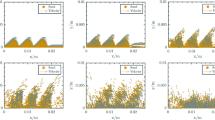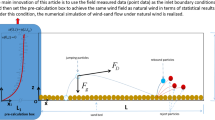Abstract
Smoothed particle hydrodynamics (SPH) method is used to numerically simulate the wind-sand flow movement of multi-diameter sand. The main feature of this method is meshless discretization of computational domain. The problem domain is represented by a series of particles with their own physical properties and arbitrary distribution. Particles produced by this method can be endowed with the natural properties of sand and air in wind-sand flow. By solving each particle, a more accurate numerical solution can be obtained, so the application of SPH in the microscopic study of wind-sand flow can accurately track the trajectory of a single sand particle, which is also the advantage of SPH in the study of wind-sand flow. This paper expounds the theoretical basis and specific methods of SPH method for multi-diameter sand and optimizes the wind-sand flow model, so that the multi-diameter sand is more in line with the natural accumulation state of the sand bed, and the simulation results of the wind-sand flow model are more accurate and rigorous. Through the SPH numerical simulation of the wind-sand flow structure of multi-diameter sand, the simulation results are studied macroscopically and microscopically. Compared with the previous research results, the validity of the SPH method in the numerical simulation of wind-sand flow of multi-diameter sand is verified. By comparing the simulation results of the wind-sand flow of multi-diameter sand and single-diameter sand, it is confirmed that the simulation results considering sand with multi-diameter distributions are more accurate than those with single-diameter in the wind-sand flow.









Similar content being viewed by others
References
Bagnold RA (2012) The physics of blown sand and desert dunes. Courier Corporation
Huang N, Zheng XJ (2006) The numerical simulation of the evolution process of wind-blown sand saltation and effects of electrostatical force. Chin J Theor Appl Mech 38(2):145–152
He DL (1985) Problems on formation mechanism of aeolian landform. J Desert Res 5(1):33
Chen FZ, Qiang HF, Gao WR (2014) Simulation of aeolian sand transport with SPH-FVM coupled method. Acta Phys Sin 63(13):14–26
Zhou F, Qi HY, You CF, Xu XC (2004) Numerical simulation of wind-sand current and boundary conditions in a limited space. J Tsinghua Univ (Sci Technol) 44(8):1079–1082
Zhou J, Fu BF, Si GH, She X, Li Z (2018) An Euler-Lagrangian numerical model of saltation. Meteorol Disaster Reduct Res 4:293–297
Li WQ, Zhou YH, Zheng XJ (2006) Discrete dynamics simulation on developing process of aeolian sand saltation. J Desert Res 26(1):47–53
Liu MB, Zong Z, Chang JZ (2011) Developments and applications of smoothed particle hydrodynamics. Adv Mech 41(2):217–234
Jin AF, Geni M, Hu GY, Mou YY (2014) Study on the threshold fluid wind velocity for sand particle take-off using the SPH method. Eng Mech 31(9):14–20
Mou YY, Jin AF, Bie YN (2015) SPH numerical simulation of windblown sand movement over the slope surface. Arid Zone Res 6:1140–1145
Gingold RA, Monaghan JJ (1977) Smoothed particle hydrodynamics: theory and application to non-spherical stars. Mon Not R Astron Soc 181(3):375–389
Monaghan JJ, Gingold RA (1983) Shock simulation by the particle method SPH. J Comput Phys 52(2):374–389
Zheng X (2009) Mechanics of wind-blown sand movements. Springer
Wu JJ, Yan GH (2008) Force analysis of sand grain jump movement in multi-field coupling of wind, sand and electricity. Sci China Ser G Phys 38(8):973–983
Xu JG, Huang N, Shi GT, Zheng XA (2021) Numerical simulation of wind-sand flow field of railway gentle embankment. J Lanzhou Jiaotong Univ 3:78–85
Zhu J, Li HS, Cai RC, Chen BF (2020) SPH liquid simulation method based on adaptive smooth length. Appl Res Comput 9:2871–2875
Dong F, Liu AY, He DL (1995) Research progress and development trend of wind-sand movement. Adv Mech 25(3):368–391
Kang LQ, Gao YQ, Zhang W, Zhou XY (2020) Characteristics of instantaneous sediment transport in steady aeolian sand transport. J Desert Res 40(1):166–172
Li ZY, Li YT, Wang S, Fang F, Geng YM (2007) Simulation study on sand transport rate near ground surface. Arid Zone Res 24(6):801–804
Zheng XJ, Zhu W, Xie L (2008) A probability density function of sand grain jumping velocity in the case of mixed size wind sand flow. Sci China Ser G Phys 38(6):668–677
Feng DJ, Ni JR, Li ZS (2007) Vertical mass flux profiles of different grain size groups in aeolian sand transport. Acta Geogr Sin 62(11):1194–1203
Li ZQ, Wang Y, Zhang Y (2010) Digital image analysis on motion parameters of saltating sand grains. J Xi’an Jiaotong Univ 44(7):109–113
Dong ZB, Wang HT, Liu XP (2002) Velocity profile of a sand cloud blowing over a gravel surface. Geomorphology 45:277–289
Wang HT, Dong ZB, Zhang XH (2004) A study of the particle concentration in the sand flux—a wind tunnel investigation. Adv Earth Sci 19(5):732
He YF, Wang ZQ, Fu BF, Zhang YH, Ma YM (2014) Numerical simulation of mixed sand saltation. J Arid Land Resour Environ 1:49–54
Kang YD, Yang XH, Huo W (2019) Field observation and analysis of sediment transport rate in sand dust weather. Desert Oasis Meteo 01:63–69
Shao Y, Raupach MR (1992) The overshoot and equilibration of saltation. J Geophys Res Atmos 97(D18):20559–20564
Acknowledgements
This work is supported by the National Natural Science Foundation of China (51968069, 11662019).
Author information
Authors and Affiliations
Corresponding author
Ethics declarations
Conflict of interest
The authors declare that they have no conflict of interest.
Additional information
Publisher's Note
Springer Nature remains neutral with regard to jurisdictional claims in published maps and institutional affiliations.
Rights and permissions
Springer Nature or its licensor (e.g. a society or other partner) holds exclusive rights to this article under a publishing agreement with the author(s) or other rightsholder(s); author self-archiving of the accepted manuscript version of this article is solely governed by the terms of such publishing agreement and applicable law.
About this article
Cite this article
An, Z., Jin, A. & Musa, R. SPH numerical simulation study on wind-sand flow structure of multi-diameter sand. Comp. Part. Mech. 10, 747–756 (2023). https://doi.org/10.1007/s40571-022-00529-y
Received:
Revised:
Accepted:
Published:
Issue Date:
DOI: https://doi.org/10.1007/s40571-022-00529-y




